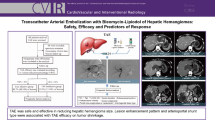Abstract
Purpose
To demonstrate the utility of ultrasound (US) guidance in improving the safety and efficacy of transjugular liver biopsy (TJLB) by analyzing all the TJLBs performed by us in the last 4 years.
Materials and methods
Forty-seven patients who underwent TJLB in the last 4 years in our two centers were retrospectively analyzed. US guidance was used for all but for one patient during the two crucial steps of the procedure—for internal jugular vein (IJV) access and during the parenchymal biopsy. Biopsies were obtained under real-time sonographic guidance from the right lobe after confirming an adequate room for needle throw without breaching the liver capsule or any major hilar structures. Post-procedure complications, tissue yield, and histopathological adequacy of samples were analyzed.
Results
Overall technical success rate was 100%. No major complications were found where ultrasound-assisted TJLB (uTJLB) was performed. One patient who underwent non-US guided TJLB had an event of a capsular breach and intra-peritoneal hemorrhage requiring coil embolization. Samples were of adequate dimension. Histopathological positivity was 100%. The overall complication rate for uTJLB was 4.7% which was due to minor complications in two patients.
Conclusions
Addition of US unit to the angiographic suite is effortless and Interventional Radiologists being already skilled in US can easily implement this simple yet valuable modification to conventional TJLB procedures. Our experience on uTJLB further emphasizes the role of US guidance in improving the procedural success rate, safety profile, and efficacy in the histopathological outcome of TJLB in all patients irrespective of age and disease burden.








Similar content being viewed by others
References
Dotter CT (1964) Catheter biopsy: experimental technique for transvenous liver biopsy. Radiology. 82(2):312–314
Kaye R, Sane SS, Towbin RB (2000) Pediatric intervention: an update–part II. J Vasc Interv Radiol JVIR. 11(7):807–822
Bruzzi JF, O’Connell MJ, Thakore H, et al. (2002) Transjugular liver biopsy: assessment of safety and efficacy of the Quick-Core biopsy needle. Abdom Imaging. 27(6):711–715
Behrens G, Ferral H (2012) Transjugular liver biopsy. Semin Interv Radiol. 29(2):111–117
Ble M, Procopet B, Miquel R, Hernandez-Gea V, García-Pagán JC (2014) Transjugular liver biopsy. Clin Liver Dis. 18(4):767–778
Bull HJ, Gilmore IT, Bradley RD, Marigold JH, Thompson RP (1983) Experience with transjugular liver biopsy. Gut. 24(11):1057–1060
Sacks D, McClenny TE, Cardella JF, Lewis CA (2003) Society of Interventional Radiology clinical practice guidelines. J Vasc Interv Radiol JVIR. 14(9 Pt 2):S199–S202
Kalambokis G, Manousou P, Vibhakorn S, et al. (2007) Transjugular liver biopsy–indications, adequacy, quality of specimens, and complications—a systematic review. J Hepatol. 47(2):284–294
Soyer P, Lacheheb D, Levesque M (1993) High-resolution sonographic guidance for transjugular liver biopsy. Abdom Imaging. 18(4):360–362
Mammen T, Keshava SN, Eapen CE, et al. (2008) Transjugular liver biopsy: a retrospective analysis of 601 cases. J Vasc Interv Radiol JVIR. 19(3):351–358
Lebrec D, Goldfarb G, Degott C, Rueff B, Benhamou JP (1982) Transvenous liver biopsy: an experience based on 1000 hepatic tissue samplings with this procedure. Gastroenterology. 83(2):338–340
Smith TP, Presson TL, Heneghan MA, Ryan JM (2003) Transjugular biopsy of the liver in pediatric and adult patients using an 18-gauge automated core biopsy needle: a retrospective review of 410 consecutive procedures. Am J Roentgenol. 180(1):167–172
Patel A, Gogna A, Irani FG, et al. (2014) Single centre experience of transjugular liver biopsy in 152 patients. Ann Acad Med Singapore. 43(3):160–165
Cholongitas E, Quaglia A, Samonakis D, et al. (2006) Transjugular liver biopsy: how good is it for accurate histological interpretation? Gut 55(12):1789–1794
Livingstone RS, Keshava SN (2011) Technical note: reduction of radiation dose using ultrasound guidance during transjugular intrahepatic portosystemic shunt procedure. Indian J Radiol Imaging. 21(1):13–14
Acknowledgements
The authors would specially like to thank Mrs. Rama, IR nurse and Mrs. Kalpana, research analyst for the help during data collection.
Author information
Authors and Affiliations
Corresponding author
Rights and permissions
About this article
Cite this article
Sebastian, B., Singhal, S., Botcha, S. et al. The utility of ultrasound guidance in transjugular liver biopsy: our experience. Abdom Radiol 44, 749–755 (2019). https://doi.org/10.1007/s00261-018-1736-4
Published:
Issue Date:
DOI: https://doi.org/10.1007/s00261-018-1736-4




